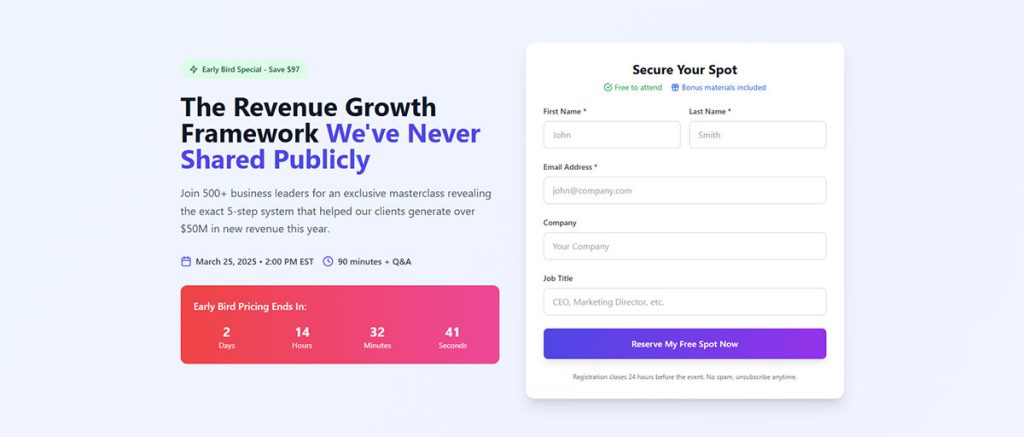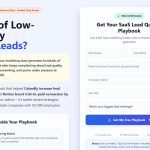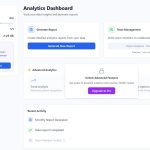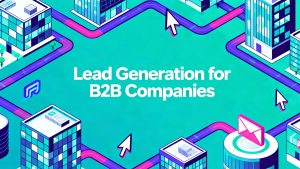Empty rooms generate zero revenue. That’s the brutal math every hotelier faces daily. Lead generation for hotels solves this problem by building a consistent pipeline of potential guests before they…
Table of Contents
Your webinar registration forms decide whether prospects become attendees or abandon ship. Poor signup experiences kill conversions before events even start.
Most businesses lose 60% of potential registrants during the signup process. Confusing forms, slow load times, and unclear value propositions drive people away instantly.
Smart webinar registration forms do more than collect emails. They build anticipation, establish credibility, and create seamless user experiences that convert browsers into engaged participants.
This guide covers everything from crafting compelling headlines to optimizing technical performance. You’ll learn proven strategies for:
- Writing titles that grab attention and drive clicks
- Designing forms that convert without friction
- Building trust through professional presentation
- Testing and improving registration rates
Whether you’re using Zoom, GoToWebinar, or Eventbrite, these techniques work across all major webinar platforms. Transform your event marketing with registration systems that actually convert.
Creating Compelling Webinar Titles and Descriptions
Writing Headlines That Grab Attention
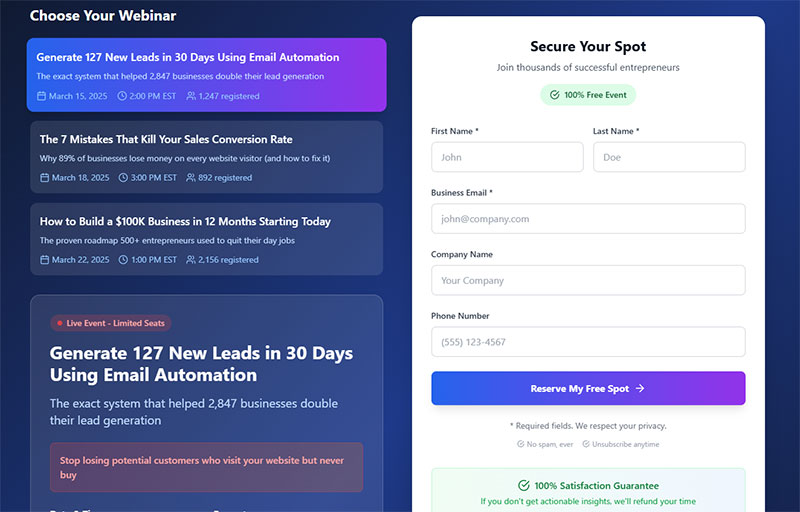
Your webinar title decides whether someone clicks or scrolls past. Numbers work. “5 Ways to Double Your Sales” beats “Sales Growth Strategies” every time.
Specific benefits convert better than vague promises. Instead of “Marketing Tips,” try “Generate 50 New Leads in 30 Days Using Email Automation.” Your audience needs to know exactly what they’ll get.
Pain points grab attention fast. Address the problems keeping your target audience awake at night. “Stop Losing Customers to Competitors” hits harder than “Customer Retention Best Practices.”
Testing Headlines for Maximum Impact
Run A/B tests on different headline formulas. Try these proven structures:
- How to [achieve desired outcome] in [timeframe]
- The [number] mistakes that [cause pain point]
- Why [common belief] is wrong (and what to do instead)
platforms like GoToWebinar and Zoom make testing simple. Split your audience and track which version gets more attendee registration.
Developing Descriptions That Convert
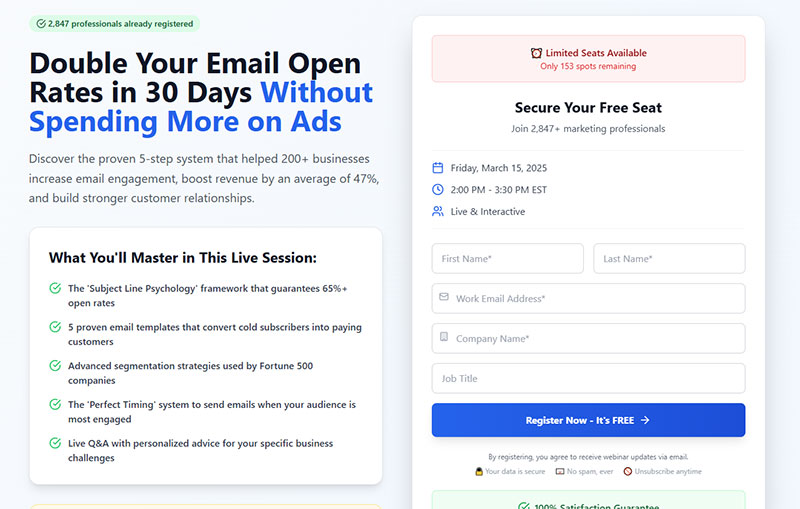
Lead with your biggest benefit. Don’t bury the value proposition in paragraph three. Your first sentence should make people think “I need this.”
Bullet points work better than walls of text. Break down key takeaways:
- What attendees will learn
- Tools they’ll walk away with
- Problems you’ll solve
- Exclusive content they can’t find elsewhere
Social proof builds credibility fast. Mention speaker credentials upfront. “Join marketing director Sarah Chen, who helped Salesforce increase conversions by 300%” carries weight.
Your call-to-action needs clarity. “Register now to secure your spot” works better than “Learn more.” Make the next step obvious.
Choosing Keywords for Discoverability
Research what your audience actually searches for. Google Keyword Planner shows real search volume. Look for terms like “virtual event signup,” “online seminar registration,” and “webinar booking.”
Industry language matters, but don’t sacrifice clarity. Balance technical terms with plain English. Your content should rank well AND make sense to humans.
When optimizing webinar platform pages, include related terms naturally. Event marketing, audience engagement, and lead generation fit together logically. Search engines understand context better than keyword density.
Designing User-Friendly Registration Forms
Simplifying the Registration Process
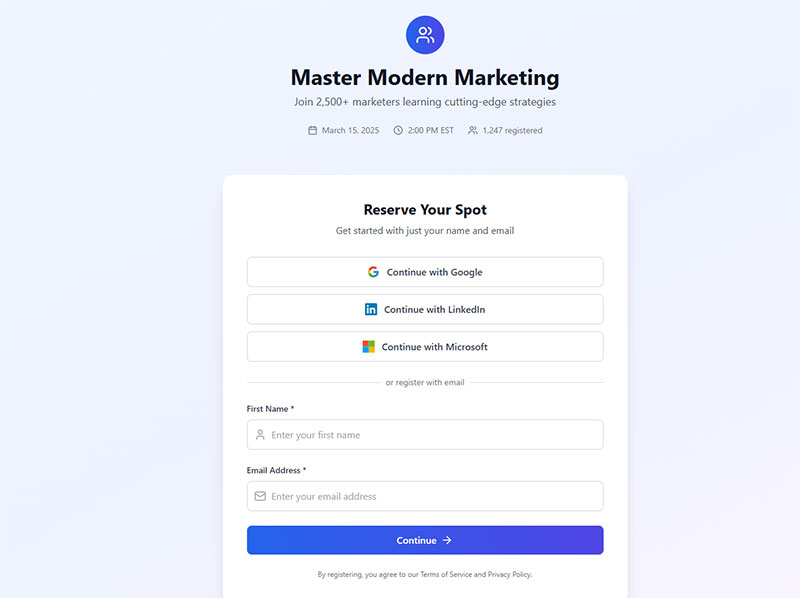
Every extra field costs you registrations. Start with email and name only. You can collect more data later through email marketing campaigns.
Progressive disclosure reduces friction. Show basic fields first, then reveal additional options. Typeform and JotForm handle this well with their multi-step forms that guide users through each section.
Single-click registration through Google or LinkedIn removes barriers. HubSpot reports 40% higher conversion rates with social login options.
Mobile users abandon forms quickly. Test your registration flow on phones. Buttons need proper spacing. Text should be readable without zooming.
Speed Matters More Than You Think
Page load times above three seconds kill conversions. Compress images. Minimize code. Use reliable hosting that handles traffic spikes during promotional campaigns.
Consider using WordPress forms for faster implementation. Popular types of forms include embedded widgets and standalone landing pages.
Asking for the Right Information
Collect only data you’ll actually use. Every field should serve a specific purpose in your marketing automation workflow.
Explain why you need information. “Phone number (for event reminders)” gets better response than just “Phone.” Transparency builds trust.
Mark optional fields clearly. Required asterisks stress people out. Use “optional” labels instead when possible.
Smart defaults save time. Pre-populate country fields based on IP location. Remember form data for returning visitors.
Data Collection Best Practices
Different webinar platforms need different information. Zoom requires minimal data. EventBrite asks for more details. Match your form to your platform’s requirements.
Consider implementing form validation to catch errors early. Real-time feedback prevents frustration at submission.
Privacy matters more than ever. Include clear statements about data usage. GDPR compliant forms protect both you and your registrants.
Creating Visual Appeal and Trust
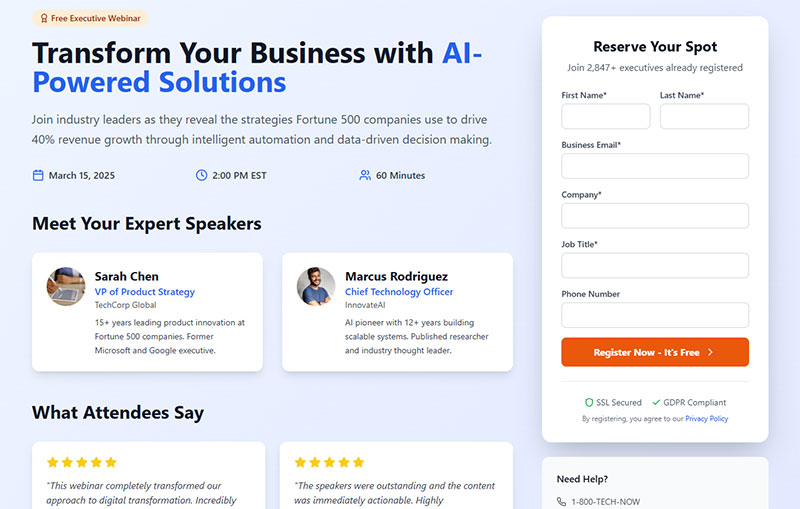
Consistent branding builds recognition. Use your company colors, fonts, and logo throughout the registration experience. Professional design suggests professional content.
Security badges reduce anxiety. Display SSL certificates and privacy policy links prominently. Trust signals matter especially for B2B audiences.
Speaker photos add human elements. People register for people, not just topics. Include brief bios highlighting relevant experience and credentials.
Color psychology influences action. Orange and red buttons typically convert better than blue or green. Test different combinations with your audience.
Building Credibility Through Design
Include logos of well-known clients or partners. Social proof works at the visual level too. Testimonials from previous webinar attendees carry significant weight.
Contact form elements like phone numbers and physical addresses build trust. Even virtual events benefit from real-world credibility markers.
Consider adding live chat support during peak registration periods. Immediate help removes final barriers to signup.
Track form abandonment to identify problem areas. Analytics tracking shows where people drop off. Address those friction points first.
Remember that registration forms serve multiple purposes beyond data collection. They set expectations for event quality and professionalism.
Writing Persuasive Copy That Converts
Creating Benefit-Focused Headlines
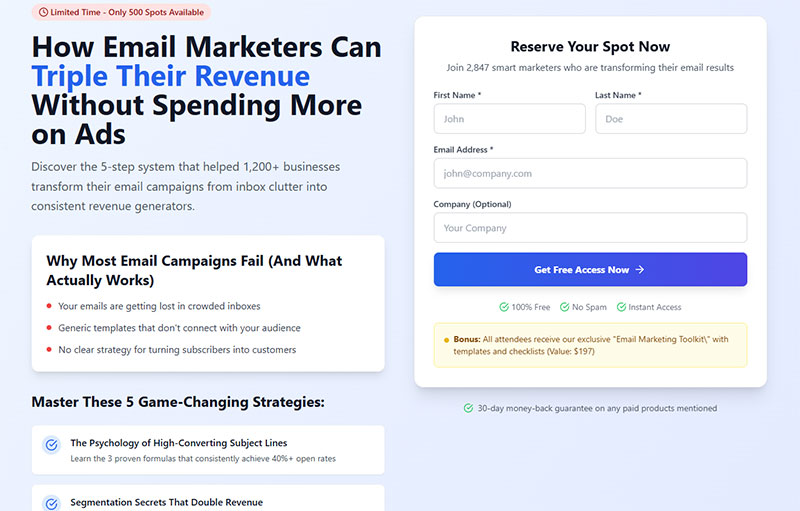
Focus on what attendees gain. “Master Email Marketing in 60 Minutes” beats “Email Marketing Webinar” every time. Specific outcomes drive action.
Action words create excitement. “Discover,” “unlock,” “transform,” and “master” energize your audience. Passive language kills momentum.
Address real problems your audience faces. Research pain points through customer surveys, social media comments, and support tickets. Your headline should make people think “finally, someone gets it.”
Test different approaches systematically. ActiveCampaign users can split test subject lines and registration page headlines. Track which versions generate higher conversion rates.
Proven Headline Formulas
These structures work across industries:
- “How [target audience] can [achieve outcome] without [common obstacle]”
- “The [number] secrets [authority figure] uses to [desired result]”
- “Why [common approach] fails (and what works instead)”
Keep testing. What works for SaaS companies might flop for consultants. Your audience determines your best approach.
Building Credibility Through Copy
Speaker expertise sells webinars. Lead with credentials that matter to your audience. “20 years of experience” means less than “helped 500+ companies reduce churn by 40%.”
Case studies provide concrete proof. Share specific results from real clients. “Increased conversions by 150%” carries more weight than “improved performance significantly.”
Testimonials from previous webinar attendees work best. Generic product reviews don’t match event-specific feedback. Collect quotes about content quality, actionable insights, and speaker expertise.
Name-drop strategically. Mentioning work with Microsoft, Salesforce, or other recognizable brands builds instant credibility. Use logos when permitted.
Social Proof That Converts
Include registration numbers when impressive. “Join 5,000+ marketing professionals” suggests popularity and value. Skip this if numbers are low.
Media mentions boost authority. “As featured in Forbes” or “quoted in Harvard Business Review” elevate your credibility quickly.
Industry certifications matter for B2B audiences. HubSpot certifications, Google Analytics expertise, or relevant professional credentials all help.
Creating Urgency Without Being Pushy
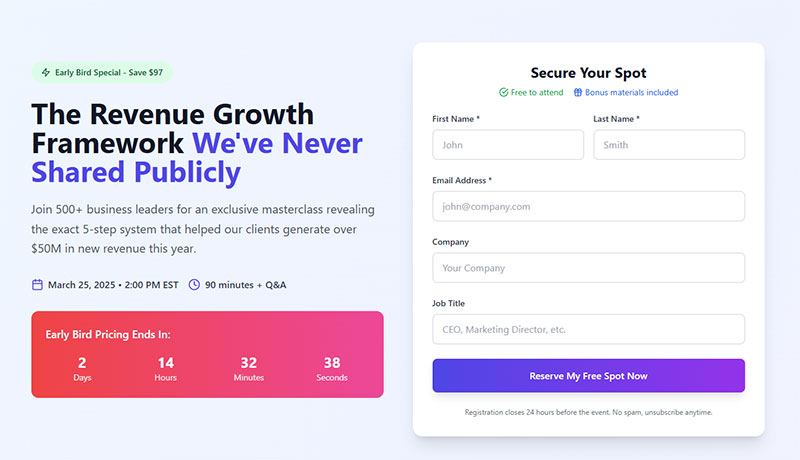
Limited-time bonuses work better than artificial scarcity. Offer exclusive resources, bonus sessions, or early access to recordings for early registrants.
Mention actual capacity limits only when true. Webex and Zoom have real participant limits. Use these honestly rather than creating fake urgency.
Registration deadlines create natural urgency. Set cutoffs 24-48 hours before your event. This allows time for reminder emails while maintaining pressure.
Exclusive content drives action. Promise insights not available elsewhere. “Get the framework we’ve never shared publicly” motivates registrations better than “learn best practices.”
Urgency Tactics That Work
Early-bird pricing creates immediate action. Offer discounts for the first 100 registrants or those who sign up within 48 hours of announcement.
Bonus materials for prompt registration work well. Extra worksheets, templates, or follow-up sessions reward quick decision-makers.
Time-sensitive partnerships add value. “Only available during this webinar” for special offers or exclusive access creates real urgency.
Technical Setup and User Experience
Choosing the Right Registration Platform
Compare features across popular platforms. GoToWebinar offers robust analytics but costs more than Zoom. Microsoft Teams integrates well with Office 365 workflows.
Consider your existing tech stack. If you use Mailchimp for email marketing, choose platforms with strong integrations. Zapier connects most webinar tools with your CRM.
Evaluate mobile compatibility carefully. Over 50% of registrations happen on phones. Test the complete signup flow on different devices and browsers.
Integration capabilities determine long-term success. Your webinar platform should connect with your email automation, CRM, and analytics tools seamlessly.
Platform Comparison Factors
Registration limits vary significantly. Google Meet caps at 100 participants. Eventbrite handles thousands but focuses more on ticketing than webinar features.
Customization options affect branding consistency. Some platforms allow full form design control while others offer basic templates only.
Analytics depth matters for optimization. Detailed tracking shows registration sources, drop-off points, and attendee engagement patterns.
Optimizing Load Times and Performance
Fast hosting prevents registration abandonment. Compress images to under 100KB. Minimize JavaScript and CSS files. Every second of delay costs conversions.
Test across devices and browsers religiously. Safari handles forms differently than Chrome. iOS users interact with mobile forms differently than Android users.
Set up proper tracking before launch. Google Analytics, Facebook Pixel, and platform-specific analytics need configuration. Track registration sources, conversion rates, and user behavior.
Content delivery networks (CDNs) speed up global access. If you’re targeting international audiences, CDNs reduce load times significantly.
Performance Optimization Checklist
- Image compression below 100KB
- Minified CSS and JavaScript
- Browser caching enabled
- Mobile-responsive design tested
- Form validation working properly
- Analytics tracking configured
Consider using web forms hosted on reliable platforms rather than custom coding everything from scratch.
Providing Clear Next Steps After Registration
Immediate confirmation emails set expectations. Include webinar details, calendar invites, and preparation instructions. Automated workflows through ConvertKit or GetResponse handle this seamlessly.
Calendar integration prevents no-shows. Automatically add events to Google Calendar, Outlook, and Apple Calendar. Include webinar links and dial-in information.
Share preparation materials strategically. Too much overwhelms people. One or two relevant resources work better than comprehensive resource libraries.
Set clear expectations for webinar day. Explain technical requirements, optimal browsers, and backup access methods. Prevention beats troubleshooting during live events.
Post-Registration Workflow
Send confirmation immediately with all essential details. Include backup contact information for technical issues.
Follow up 24 hours before with reminder emails. Include last-minute preparation tips and final registration deadline information.
Consider using registration successful message templates that provide immediate value while confirming signup completion.
Implement conditional logic in follow-up sequences. Segment registrants by role, company size, or interest level for targeted communications.
Track engagement with preparation materials. This data helps identify highly qualified leads for sales follow-up after your webinar ends.
Promotional Strategies to Increase Visibility
Email Marketing for Webinar Promotion
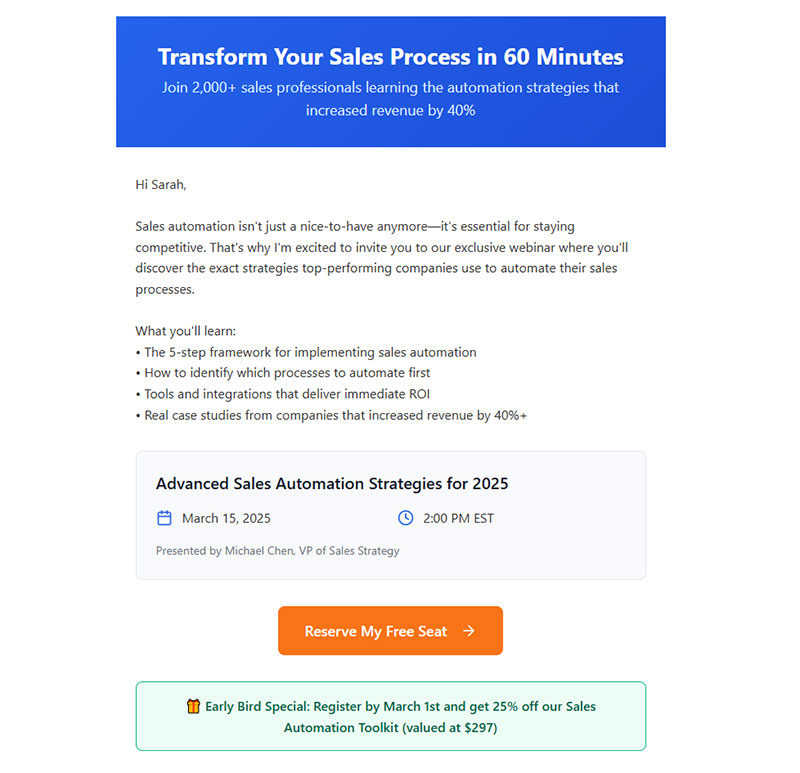
Segment your list strategically. B2B prospects need different messaging than existing customers. Mailchimp and ActiveCampaign make audience segmentation simple through behavioral triggers and demographic data.
Create email sequences, not single blasts. Start with announcement emails, add value-driven content, then send reminder messages. ConvertKit automates this workflow perfectly.
Subject lines determine open rates. Test “How to [solve problem]” against “[Number] ways to [achieve outcome].” Track performance across different segments.
Include clear registration buttons in every email. Make the path to signup obvious. AWeber and GetResponse provide optimized email templates with prominent call-to-action buttons.
Email Campaign Structure
- Week 1: Announcement with early-bird incentives
- Week 2: Value-focused content related to webinar topic
- Final week: Urgency-driven reminders with registration deadline
Personalization boosts engagement. Use first names, company data, and past webinar attendance to customize messages. Campaign Monitor excels at dynamic content insertion.
Social Media Promotion Tactics
Visual content drives engagement. Create shareable graphics highlighting key takeaways, speaker credentials, and event details. Canva templates work well for consistent branding.
Time posts for maximum visibility. LinkedIn performs best Tuesday through Thursday, 8-10 AM. Twitter peaks during commute hours. Platform analytics reveal your audience’s active periods.
Use relevant hashtags strategically. Research industry-specific tags and trending topics. Mix popular hashtags with niche ones for broader reach.
Tag speakers and encourage network sharing. Their followers represent qualified prospects. Cross-promotion amplifies reach without additional advertising spend.
Platform-Specific Strategies
LinkedIn works best for B2B webinars. Share professional insights, company updates, and industry analysis. LinkedIn Events feature helps with discovery.
Twitter enables real-time engagement. Share quick tips, respond to questions, and join industry conversations. Threading multiple tweets increases visibility.
Facebook groups provide targeted access. Share value-first content in relevant professional groups. Avoid direct promotion without establishing credibility.
Partner and Influencer Outreach
Identify complementary businesses for cross-promotion. Marketing software companies partner well with sales training webinars. Both audiences benefit from shared expertise.
Reach out to industry influencers with genuine value propositions. Offer exclusive access, co-hosting opportunities, or content collaboration rather than simple promotional requests.
Create referral programs for partners. Offer commission splits, exclusive bonuses, or reciprocal promotion agreements. Eventbrite supports affiliate tracking for revenue sharing.
Document partnership agreements clearly. Define promotion requirements, timeline expectations, and compensation structures upfront to avoid misunderstandings.
Outreach Best Practices
Research potential partners thoroughly. Understand their audience, content style, and partnership history before reaching out.
Personalize outreach messages. Reference specific content, mutual connections, or shared industry interests. Generic templates get ignored.
Offer value before asking for promotion. Share their content, provide testimonials, or introduce valuable connections first.
Testing and Improving Your Registration Process
A/B Testing Key Elements
Test headlines systematically. Run “How to [achieve outcome]” against “[Number] secrets for [result]” variations. Track registration rates, not just click-through rates.
Form length significantly impacts conversions. Test minimal fields (name, email) against detailed forms with job title, company size, and specific interests. Shorter usually wins.
Button colors and text affect action rates. Orange buttons typically outperform blue ones. “Reserve my spot” converts better than “Submit” or “Register now.”
Landing page layouts need constant optimization. Test single-column designs against multi-column layouts. Mobile-first design principles usually improve overall performance.
Testing Framework
- Run tests for minimum 100 conversions per variation
- Test one element at a time for clear results
- Use statistical significance calculators before declaring winners
- Document all test results for future reference
Consider using form UX design principles when creating test variations. Small changes often produce significant improvements.
Analyzing Registration Data and Metrics
Track registration sources meticulously. Google Analytics shows which channels drive highest-quality attendees. Email campaigns might generate volume while LinkedIn produces engaged participants.
Monitor drop-off points throughout the registration funnel. High abandonment at specific form fields indicates friction. Address these bottlenecks first for maximum impact.
Compare performance across different webinar topics. Technical content might attract smaller but more engaged audiences than general business topics. Adjust promotion strategies accordingly.
Measure registration-to-attendance ratios by source. Some channels produce registrants who actually show up. Others generate vanity metrics without real engagement.
Key Metrics to Monitor
- Registration conversion rate by traffic source
- Form abandonment rate at each field
- Time from landing to completed registration
- Registration-to-attendance correlation by channel
- Cost per registration across paid channels
Use improving form abandonment rate strategies when data shows specific problem areas.
Gathering Feedback and Making Adjustments
Survey registrants about their signup experience. Ask specific questions about form usability, information clarity, and mobile experience. Keep surveys short for better response rates.
Monitor social media mentions and comments about your registration process. Twitter and LinkedIn conversations reveal frustrations users might not report directly.
Analyze customer support tickets related to registration issues. Common problems indicate systematic improvements needed rather than individual user errors.
Test registration flow with real users periodically. Watch colleagues or customers complete the process while thinking aloud. This reveals usability issues analytics miss.
Feedback Collection Methods
Send post-registration surveys immediately while experience is fresh. Use tools like Typeform or Google Forms for quick implementation.
Include feedback questions in confirmation emails. “How was your registration experience?” with rating scales provides quantitative data.
Monitor live chat transcripts during peak registration periods. Support conversations highlight common confusion points and technical issues.
Implement feedback forms specifically for registration process improvement. Focus on actionable insights rather than general satisfaction scores.
Regular optimization cycles keep registration conversion rates improving. Set monthly reviews of key metrics and quarterly deep-dive analyses for strategic adjustments.
Post-Registration Engagement and Retention
Nurturing Registrants Before the Webinar
Send valuable content immediately after registration. Don’t wait until event day. Share preparation guides, relevant case studies, or exclusive industry reports within 24 hours.
Build anticipation with sneak peeks. Reveal one key insight or surprising statistic you’ll cover. This creates excitement and reduces no-show rates significantly.
Answer common questions proactively. Create FAQ emails addressing technical requirements, agenda details, and what attendees should bring. HubSpot automation makes this seamless.
Use drip campaigns through ConvertKit or Mailchimp. Space content over several days rather than overwhelming people with information dumps.
Pre-Webinar Content Strategy
- Day 1: Welcome email with calendar invite and preparation checklist
- Day 3: Industry insight or relevant case study
- Day 5: Speaker introduction with credentials and background
- Day 7: Final reminder with last-minute tips
Segment based on registration source. LinkedIn leads might want professional insights while email subscribers prefer practical tips. Tailor messaging accordingly.
Managing No-Shows and Late Registrations
Create urgency without desperation. “Final hours to register” works better than “last chance ever.” Authentic scarcity drives action while maintaining credibility.
Offer recording access strategically. Some platforms like Zoom automatically provide recordings. Use this as value-add rather than primary selling point.
Follow up with no-shows within 48 hours. Share key takeaways, offer recording access, and promote upcoming events. GetResponse handles automated follow-up sequences well.
Implement waitlists for popular webinars. Eventbrite supports this feature naturally. Waitlists create social proof while capturing interested prospects.
Last-Minute Registration Tactics
Send reminder emails to your broader list. Include social proof like current registration numbers or attendee company logos.
Use popup forms on high-traffic pages during final registration hours. Exit intent popup technology captures leaving visitors.
Partner with speakers to promote through their networks. Their last-minute push often generates quality registrations.
Converting Registrants into Long-Term Subscribers
Offer exclusive content during registration confirmation. Bonus resources, templates, or industry reports add immediate value beyond the webinar itself.
Create community around your events. LinkedIn groups, Slack channels, or Facebook communities keep engagement ongoing. Build relationships, not just email lists.
Promote upcoming webinars strategically. Mention future topics during current events. Use sign up forms to capture interest in specific subjects.
Develop email nurture sequences for webinar attendees. Different content tracks for prospects versus customers maximize relevance and engagement.
Subscriber Conversion Tactics
Include subscription forms in confirmation emails. Offer weekly insights, industry updates, or exclusive content access.
Survey attendees about future topic interests. Use this data to create targeted campaigns and demonstrate you listen to audience needs.
Provide value before selling. Share actionable insights, free tools, or industry analysis through regular email campaigns using ActiveCampaign or Campaign Monitor.
Long-Term Engagement Strategies
Create content series extending webinar topics. Blog posts, podcasts, or video tutorials keep conversations going beyond single events.
Host regular Q&A sessions for subscribers. Address questions from previous webinars and preview upcoming content.
Use lead capture forms strategically throughout your website. Connect webinar topics to broader content marketing efforts.
Track engagement metrics across platforms. Monitor email open rates, social media interactions, and website behavior to identify most engaged prospects.
Implement progressive profiling. Collect additional data over time rather than overwhelming initial registration forms. Salesforce and HubSpot excel at this gradual approach.
Personalize follow-up communications based on webinar engagement. Attendees who stayed for Q&A sessions represent higher-quality leads than early departures.
Consider creating lead generation form variations for different webinar topics. Technical content attracts different audiences than business strategy sessions.
Remember that post-registration engagement often determines actual attendance rates. Consistent, valuable communication between registration and event day significantly improves show-up rates and audience quality.
FAQ on Webinar Registration Forms
What fields should I include in my webinar registration form?
Keep it minimal. Name and email work best. Add job title for B2B events. Company size helps with segmentation. Phone numbers reduce no-shows but lower conversion rates. Test what works for your audience and webinar platform requirements.
How can I reduce form abandonment rates?
Simplify ruthlessly. Remove optional fields. Use mobile forms design principles. Add progress indicators for longer forms. Test single-step versus multi-step forms. Load pages faster. Clear error messages help too.
Which webinar platforms offer the best registration features?
GoToWebinar provides robust analytics and customization. Zoom offers simplicity and reliability. WebEx integrates well with enterprise systems. Eventbrite handles payment processing. HubSpot connects with marketing automation. Choose based on your specific needs and existing tech stack.
Should I use single-step or multi-step registration forms?
Single-step works for simple events. Multi-step reduces cognitive load for complex registrations. Test both approaches. B2B audiences often prefer progressive disclosure. Consumer events favor quick signup. Consider your audience’s patience level and information requirements.
How do I make registration forms mobile-friendly?
Use responsive design templates. Large buttons for touch screens. Minimize typing with dropdowns. Auto-populate location data. Test on actual devices, not just desktop browsers. Platforms like Typeform and JotForm offer mobile-optimized solutions by default.
What’s the ideal registration deadline before my webinar?
Set deadlines 24-48 hours before your event. This allows confirmation email delivery and calendar setup. Last-minute registrations often become no-shows. Use artificial deadlines sparingly. Real capacity limits work better than fake urgency for building trust.
How can I increase registration conversion rates?
Write benefit-focused headlines. Use social proof like attendee numbers. Add speaker credentials prominently. Create urgency with early-bird bonuses. Test different call-to-action buttons. Implement landing page forms best practices. Remove friction points systematically.
Should I require payment for webinar registration?
Free events generate higher registration volumes but more no-shows. Paid events attract serious attendees. Consider hybrid approaches: free registration with optional paid upgrades. $5-10 fees reduce no-shows without major barriers. Test what works for your audience.
How do I handle GDPR compliance for international registrants?
Use GDPR compliant forms with clear consent checkboxes. Explain data usage plainly. Provide easy unsubscribe options. Store data securely. Most major platforms like Mailchimp and ActiveCampaign handle compliance automatically for European registrants.
What confirmation process works best after registration?
Send immediate confirmation emails with calendar invites. Include webinar access details and preparation materials. Use automated sequences through ConvertKit or Campaign Monitor. Add events to Google Calendar automatically. Set clear expectations for webinar day logistics and technical requirements.
Conclusion
Effective webinar registration forms transform casual visitors into engaged participants. The difference between high-converting forms and abandoned signups lies in strategic design, compelling copy, and seamless user experience.
Success requires constant optimization. Test headlines, simplify form fields, and monitor analytics tracking across platforms like Microsoft Teams and Salesforce. Small improvements compound into significant conversion gains.
Focus on these proven strategies:
- Write benefit-focused titles that address pain points
- Minimize form fields while maximizing trust signals
- Implement mobile-responsive design for all devices
- Create urgency through authentic scarcity tactics
- Build credibility with speaker credentials and social proof
Post-registration engagement determines actual attendance rates. Automated email sequences through Marketo or Pardot keep registrants excited until event day.
Remember that registration workflow extends beyond initial signup. From confirmation messages to reminder notifications, every touchpoint influences participant engagement and long-term subscriber conversion.
